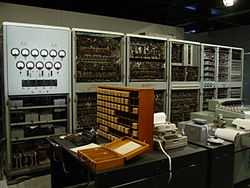CSIRAC

CSIRAC (/ˈsaɪræk/; Council for Scientific and Industrial Research Automatic Computer), originally known as CSIR Mk 1, was Australia's first digital computer, and the fifth stored program computer in the world.[1] It is the oldest surviving first-generation electronic computer[2] and was the first in the world to play digital music.[3][4]
The CSIRAC was constructed by a team led by Trevor Pearcey and Maston Beard, working in large part independently of similar efforts across Europe and the United States, and ran its first test program sometime in November 1949.
The machine was fairly representative of first-generation valve-driven computer designs. It used mercury acoustic delay lines as its primary data storage, with a typical capacity of 768 20-bit words (later doubled), supplemented by a parallel disk-type device with a total 1024-word capacity and an access time of 10 milliseconds. Its memory clock ran at 1000 Hz, and the control unit, synchronized to the clock, took two cycles to execute an instruction (later the speed was doubled to one cycle per instruction). The bus (termed the "digit trunk" in their design) is unusual compared to most computers in that it was serial—it transferred one bit at a time. The instruction set was minimal, but supported the basic set of arithmetic and logical operations, as well as conditional and relative jumps (making it possible to write a library of subroutines).
Input to the machine was performed in the form of punched paper tape, after experiments with punch cards proved unsatisfactory. The machine was controlled through a console which allowed programs to be stepped through one at a time, and featured CRT displays which showed the contents of registers. Output was through a standard teleprinter or to punch tape.
The machine, like all machines of the era, had no operating system. A high-level interpreted programming language called INTERPROGRAM was developed in 1960 by Geoff Hill. It was similar to early forms of BASIC, which was designed in 1963 for the 20-bit transistorized GE-200 series.
In 1950 or 1951, CSIRAC was used to play music, the first known use of a digital computer for the purpose. The music was never recorded, but it has been accurately reconstructed.[4]

In 1955, with the CSIRO's decision that computing research was outside its purview, the machine was transferred from its home at the Radiophysics Laboratory at the CSIRO in Sydney, to the University of Melbourne, where it formed Australia's only academic computing facility until late 1956. Many pioneers of computer use in Australia had their first exposure to computing there.
Most of CSIRAC's approximately 2000 valves were of the types 6SN7,[5] 6V6,[6] EA50 Diodes and KT66.[7] George Semkiw later redesigned the drum read electronics to use germanium transistors.
In 1964, CSIRAC was shut down for the last time. Its historical significance was already recognised at that stage, and it was placed in storage with plans for its later exhibition in a museum.
The machine was stored in a warehouse through the 1960s and 1970s, before being set up for exhibit at Caulfield Institute of Technology[8] from 1980 to 1992. It was then returned to storage.
Interest in the machine was revived in the 1990s, as it was realised that many of its developers were aging and precious history was being lost forever. A conference about the machine was held in 1996.
The machine finally found a permanent home in the Melbourne Museum in 2000. It has not been operable since its shutdown, but many of the programs that ran on it have been preserved, and an emulator has been written for it. The curators have decided that, aside from the cost of restoring the device, that the huge number of repairs that would be required to make it safe to operate (CSIRAC used 30 kilowatts of power in operation) would detract from its historical authenticity.
CSIRAC is listed on the Victorian Heritage Register and is included in a Heritage Overlay. [2]
See also
- Computer music
- Electronic music
- History of computing hardware
- List of vacuum tube computers
- SILLIAC – Sydney University's first computer
References
- References
- ↑ "CSIRAC". Retrieved 2013-06-27.
- ↑ 2.0 2.1 "CSIRAC, Victorian Heritage Register (VHR) Number H2217". Victorian Heritage Database (Heritage Victoria). Retrieved 2010-09-16.
(The Zuse Z4 at the Deutsches Museum is older, but was electro-mechanical, not electronic.) - ↑ "CSIRAC: Australia’s first computer". Retrieved 2007-12-21.
- ↑ 4.0 4.1 Fildes, Jonathan (2008-06-17). "Oldest computer music unveiled". BBC News Online. Retrieved 2008-06-18.
- ↑ 6SN7 Double Triode, 8 pin, 3.8W heater
- ↑ 6V6 Beam Power Pentode, 8 pin, 2.8W heater
- ↑ KT66 Beam Tetrode, 8 pin, 8.2W heater
- ↑ http://museumvictoria.com.au/collections/items/761661/slide-csirac-computer-trevor-pearcey-1965-1975
- Bibliography
- Beard, M.; Pearcey T. (1984). "The Genesis of an Early Stored-Program Computer: CSIRAC". IEEE Annals of the History of Computing (IEEE) 6 (2): 106–115. doi:10.1109/MAHC.1984.10014.
- Deane, John (1997). CSIRAC: Australia's first computer. Australian Computer Museum Society. pp. 45p. ISBN 0-646-34081-6.
- Doornbusch, Paul (2005). The Music of CSIRAC, Australia's first computer music. Common Ground. ISBN 1-86335-569-3.
- McCann, Doug; Thorne, Peter (2000). The Last of The First, CSIRAC: Australias First Computer. University of Melbourne Computing Science. ISBN 0-7340-2024-4. – A timeline and history of CSIRAC, as well as a collection of presentations from the 1996 conference on the machine.
- Pearcey, Trevor (1988). A History of Australian Computing. Chisholm Institute of Technology. pp. 192p. ISBN 0-947186-94-8. — An excellent history of computing in Australia, regrettably out of print and very scarce.
External links
- CSIRAC homepage – From the Computation Laboratory at the University of Melbourne's Dept of Computer Science and Software Engineering
- Australian National Treasure - CSIRAC – Television segment on CSIRAC
- The Computer 'CSIRAC' – 1965 film
- The Music Of CSIRAC – Paul Doornbusch's book review